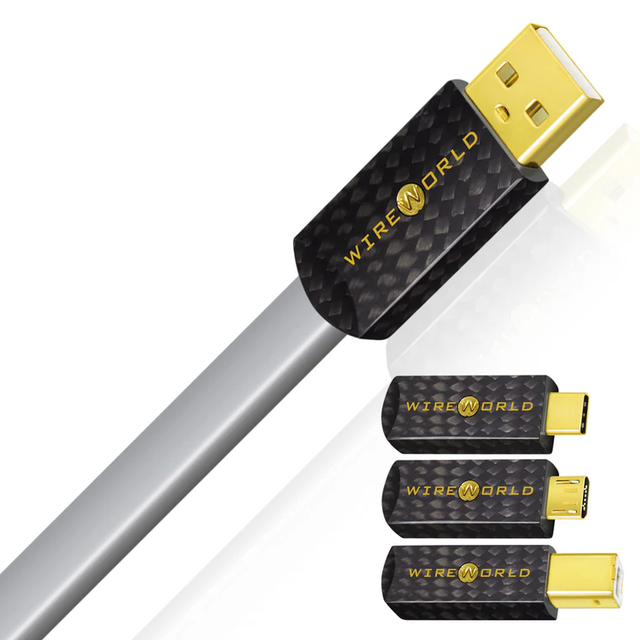When it comes to transmitting digital audio signals, there are three options. But choosing between a USB cable, an optical cable, or a coax cable can prove confusing. Depending on your equipment and the demands of the source and the output setup, the right one can make a big difference in audio quality. Let’s break down the difference in each type of cable.
Understanding Digital Audio Cables
These cables are used to connect audio devices like CD and DVD players to speakers, soundbars, receivers, and amplifiers. Unlike analog cables, which send sound along via fluctuating electric signals, digital audio cables transmit signals in a digital form.
Digital cables are better able to preserve the audio quality. They are available in three basic formats: USB, optical cable (or Toslink), and coaxial digital.
USB Audio Cables
USB audio cables are ubiquitous, transmitting digital audio signals between a source and a digital-to-analog converter (DAC). This analog signal can then be heard through speakers or headphones. This type of high-bandwidth cable is great for uncompressed audio formats like Dolby TrueHD.
When to Choose USB Audio Cables
A USB audio cable is used to connect digital audio devices, like headphones, to another digital source, like a computer. With its greater bandwidth, it provides high-resolution audio when streaming, gaming, and for audiophiles. It’s also a good choice for long cable runs in a home setting or professional setup.
Key Benefits
Because they’re specifically optimized for audio, this kind of USB cable offers reduced interference and noise. Their construction, materials, and shielding result in fewer interruptions.
Optical (Toslink) Cables
A Toslink cable uses light pulses to transmit the audio signals, versus sending them over copper wires. This kind of connection is virtually immune to electrical noise and radio frequency interference, resulting in superior audio quality.
When to Choose Toslink Optical Cables
This form of cable is often used for home theaters, gaming consoles, or connecting computers to speakers. Toslink also better preserves audio quality along long cable runs.
Key Benefits
They’re more or less immune to electromagnetic noise and interference. Toslink is also great for use in surround sound setups.
Coaxial Digital Cables
A digital coaxial cable sends the audio signals between devices through a single electrical conductor. They frequently use the familiar RCA connector and help preserve the digital format during transmission.
When to Choose Coaxial Digital Cables
Coaxial cables are a bit “old school,” but helpful when something like HDMI isn’t available.
Audiophiles often prefer the sound quality and the durable connection of coax cables.
Key Benefits
Coax cables are designed to deliver a strong signal, even over long runs. The shielding minimizes electromagnetic and radio interference, and it can handle a large bandwidth.
Final Verdict: How to Choose Based on Your Setup
The good news is that you have multiple cable options available for your digital audio setup. That’s also the bad news!
When it comes to optical vs USB vs coaxial cable connection, here’s how it breaks down and how to find the best one for your particular needs and setup.
Optical/Toslink: Uses light pulses versus sending signals over copper wires. This creates a dynamic audio experience, resistant to electromagnetic and radio interference. Ideal for home theaters, surround sound usage, gaming, and streaming.
USB Cable: A USB connection effectively transmits digital audio and data between devices. It’s very versatile and offers greater bandwidth. However, it can be susceptible to noise when connected over long distances.
Coaxial Cable:A coax cable can connect older devices to receive digital audio data; they typically use an RCA connector. They support more bandwidth than an optical cable; however, they are susceptible to signal degradation and interference over long distances.
Whatever you’re searching for, Wireworld Technology is the cable store that has you covered. We’re not just a retailer; we design and engineer audio cables for both audiophiles and professionals. Our cables feature high-quality metal conductors, layers of noise-dampening shielding, and sturdy connectors to keep audio signals and data moving flawlessly between their source and output devices.
If you’re still not sure which form of audio cable is right for you (USB, optical, or coaxial), get in touch with us. The experts at WireWorld are passionate about creating cables for exceptional performance and will help you design the ideal setup for various formats.
Audiophiles and professionals turn to WireWorld for purpose-built cables that deliver in every kind of setting and for all kinds of equipment. Explore our selection now!


